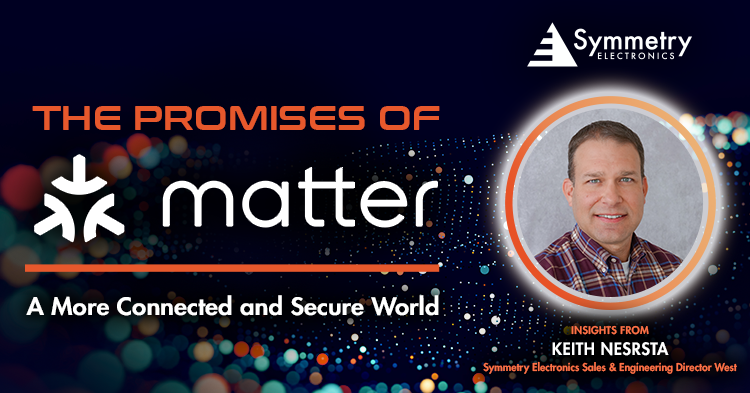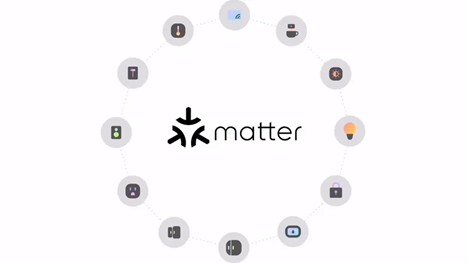- Home
- Symmetry Blog
- The Promises of Matter – A More Connected and Secure World
The Promises of Matter – A More Connected and Secure World
About Keith Nesrsta

The world of connectivity in homes, industrial segments, and other markets has historically been very fragmented and complex for those that want an automated environment. While Internet of Things (IoT) has been a part of our vernacular for more than 10 years, the IoT devices available today still require experienced professional installers or technical hobbyists.
My own home is a prime example. I have four different routers/hubs, one bridge device, and four different wireless protocols covering the 20-30+ connected devices that help automate and confuse my life (and my family’s). However, the solution may lie in Matter. The Matter protocol is enabling convenient, secure, and reliable interoperability in connected devices and systems.

3 Obstacles Facing Automated Environments
If you have attempted to build out your own automated environment or tried to add to your networks, then you have likely experienced the following key frustrations.
- Lack of interoperability between different devices and platforms.Many smart home devices are designed to work with specific ecosystems (like Amazon Alexa or Google Home) and may not be compatible with other systems. This can make it difficult for consumers to build a cohesive and integrated smart home system.
- The complexity of setting up and managing smart home devices. Many devices require a significant amount of technical knowledge to install and configure, which can be a barrier to adoption for many consumers.
- The need for private and secure connection. Smart home devices are connected to the internet, which means they are vulnerable to cyber-attacks. As a result, security and privacy concerns are a major frustration for many consumers who are worried about the potential risks of having smart devices in their homes.
Matter in Home Automation
The home automation industry has been expanding rapidly over the past few years, with the proliferation of connected devices and the rise of smart homes. Bloomberg reports that the smart home automation market is expected to reach $444.98 billion by 2023. However, this rapid growth has also led to a proliferation of different standards and protocols, making it difficult for consumers to choose compatible devices and create a cohesive smart home system. The Matter protocol aims to solve this problem by providing a unified standard that can be used by smart home devices from different manufacturers. This means that consumers can choose devices based on their individual needs and preferences, without having to worry about whether they will be able to communicate with other devices in their homes.
Additionally, the Matter protocol offers the following benefits for the home automation industry. The Matter protocol features:
- Secure Design – Matter has strong encryption and authentication mechanisms built in. This helps to protect against cyber threats and ensure the privacy of user data.
- Scalability – The Matter protocol is suitable for use in large homes and commercial buildings. It can support thousands of devices on a single network, without sacrificing performance or reliability.
- Convenience – Matter is a user-friendly protocol with simple setup and configuration processes. This makes it accessible to a wider range of users, including those who are less technically savvy.
Matter in the Industrial Segment
The industrial segment is another area where the Matter protocol can offer significant value. In industrial settings, there is often a need to connect a wide range of devices from different manufacturers, such as sensors, controllers, and actuators. However, the lack of a unified standard can make this difficult, leading to compatibility issues and increased costs.
Matter addresses these challenges by providing a single standard for communication between industrial devices. This can help reduce costs and simplify the integration of different devices into industrial control systems.
Matter also offers several other benefits for the industrial segment. The Matter protocol is designed to be:
- Reliable – Matter has robust error handling and fault tolerance mechanisms. This helps to ensure that industrial control systems operate safely and efficiently, without interruption.
- Interoperable – Matter enables seamless connection between devices from different manufacturers. This helps to facilitate collaboration and innovation in the industrial sector.
- Future-Proof – The Matter protocol supports new device types and communication technologies as they emerge. This helps to ensure that industrial control systems can evolve and adapt to changing needs over time.
Conclusion
The Matter protocol offers significant value for both the home automation and industrial segments. By providing a unified standard for communication between devices from different manufacturers, it can help to simplify device integration, reduce costs, and improve security and reliability. As the adoption of the Matter protocol continues to grow, we can expect to see an increasing number of smart home and industrial devices that are compatible with this new standard. Symmetry Electronics has a variety of partners with Matter solutions available today. Reach out to Symmetry Electronics to get started today!
